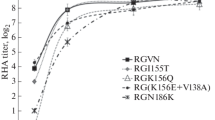Abstract
The nucleoprotein (NP) of influenza virus is a multifunctional RNA binding protein. The role of NP in the adaptation of influenza viruses to a host has been experimentally proved. Ambiguous data are available on the role of nucleoprotein in the attenuation of influenza A viruses, which is characterized by ability to replicate at low temperature (26°C) and inability to replicate at high temperature (39°C). Influenza virus donor strain A/Hong Kong/1/68/162/35 (H3N2), adapted to growth at low temperature, differs from the wild type virus by 14 amino acid mutations in the internal and non-structural proteins. Two mutations occurred in the NP: Gly102Arg and Glu292Gly. We have obtained viruses with point reverse-mutations in these positions and compared their replication at different temperatures by measuring infectious activity in chicken embryos. It has been shown that reverse mutation Gly292Glu in the NP reduced virus ability to replicate at low temperature, the introduction of the second reverse mutation Arg102Gly completely abolished virus cold adaptation.
Similar content being viewed by others
Abbreviations
- att:
-
attenuated (phenotype)
- ca:
-
cold adapted (phenotype)
- NP:
-
nucleoprotein
- RCT37, RCT26 :
-
reproductive capacity at different temperatures
- ts:
-
temperature sensitive (phenotype)
- CE:
-
embryonated chicken eggs
- EID50 :
-
50% embryo infectious dose.
References
Portela A., Digard P 2002. The influenza virus nucleoprotein: A multifunctional RNA-binding protein pivotal to virus replication. J. Gen. Virol. 83, 723–734.
Gabriel G., Klingel K., Otte A., Thiele S., Hudjetz B., Arman-Kalcek G., Sauter M., Shmidt T., Rother F., Baumgarte S., Keiner B., Hartmann E., Bader M., Brownlee G.G., Fodor E., Klenk H.D 2011. Differential use of importin-a isoforms governs cell tropism and host adaptation of influenza virus. Nat. Commun. 2, 156.
Hoffmann E., Mahmood K., Chen Z., Yang C.F., Spaete J., Greenberg H.B., Herlocher M.L., Jin H., Kemble G 2005. Multiple gene segments control the temperature sensitivity and attenuation phenotypes of ca B/Ann Arbor/1/66. J. Virol. 79, 11014–11021.
Aleksandrova G.I., Klimov A.I 1994. Zhivaya vaktsina protiv grippa (Live Anti-Influenza Vaccine). St. Petersburg: Nauka.
Kiseleva I.V., Larionova N.V., Voeten J.T.M., Teley L.C.T., Driezen-van der Cruijsen S.K.M., Heldens J.G.M., van der Bosch J.F., Rudenko L.G 2010. The leading role of the polymerase complex genes in attenuation of donor virus used in domestic live influenza A and B vaccine. Zh. Mikrobiol. Epidemiol. Immunol. 6, 41–47.
Isakova-Sivak I., Chen L.M., Matsuoka Y., Voeten J.T., Kiseleva I., Heldens J.G., den Bosch Hv., Klimov A., Rudenko L., Cox N.J., Donis R.O 2011. Genetic bases of the temperature-sensitive phenotype of a master donor virus used in live attenuated influenza vaccines: A/Leningrad/134/17/57 (H2N2). Virology. 412, 297–305.
Tsybalova L.M., Gorev N.E., Potapchuk M.V. Repko I.V., Korotkov A.V., Sergeeva M.V., Komissarov A.B., Pisareva M.M., Kuznetsov V.V, Grudinin M.P., Kiselev O.I 2012. Characterization of cold-adapted influenza strain A/HongKong/1/68/162/35 as a potential donor of attenuation and high reproduction. Vopr. Virusol. 57, 15–17.
Pettersen E.F., Goddard T.D., Huang C.C., Couch G.S., Greenblatt D.M., Meng E.C., Ferrin T.E 2004. UCSF Chimera: A visualization system for exploratory research and analysis. J. Comput. Chem. 25, 1605–1612.
Romanova J., Krenn B.M., Wolschek M., Ferko B., Romanovskaja-Romanko E., Morokutti A., Shurygina A.P., Nakowitsch S., Ruthsatz T., Kiefmann B., König U., Bergmann M., Sachet M., Balasingam S., Mann A., et al 2009. Preclinical evaluation of a replication-deficient intranasal DeltaNS1 H5N1 influenza vaccine. PLoS ONE. 4, 5984.
Kiselev O.I., Blinov V.M., Pisareva M.M., Ternovoi V.A., Agafonov A.P., Saraev D.V., Eropkin M.Yu., Lobova T.G., Grigorieva V.A., Grudinin M.P 2008. Molecular genetic characterization of H5N1 influenza virus strains isolated from poultry in the Kurgan region i 2005. Mol. Biol. (Moscow). 42(1), 70–78.
Potapchuk M.V., Repko I.A., Sergeeva M.V., Korotkov A.V., Komissarov A.B., Sandybaev N.T., Chervyakova O.V., Khairulin B.M., Tsybalova L.M 2012. Characteristics of reassortant influenza virus strains based on a new donor, A/HongKong/1/68/162/35 (H3N2). Vopr. Virusol. 57, 42–46.
Hirst G.K 1941. The agglutination of red cells by allantoic fluid of chick embryos infected with influenza virus. Science. 94, 22–23.
Reed L.J., Muench H 1938. A simple method of estimating fifty percent endpoints. Am. J. Hygiene. 27, 493–497.
Kiseleva I.V 2001. Principles of influenza virus attenuation. Doctoral (Biol.) Dissertation. St. Petersburg.
Ksenofontova O. I., Kuznetsov V.V., Garmai Yu.P., Egorov V.V 2012. An explanation to the cold-adapted nature of influenza virus A/H3N2/HongKong/1/68 with a mutation in residue 292 of the NP gene. In: Sbornik statei konferentsii molodykh spetsialistov “Gripp: epidemiologiya, virusologiya, profilaktika i lechenie” (Influenza: Epidemiology, Virology, Prevention, and Treatment. Proc. Young Sci. Conf.). St. Petersburg, pp. 5–7.
Varich N.L., Sadykova G.K., Prilipov A.G., Kochergin-Nikitsky K.S., Kushch A.A., Masalova O.V., Klimova R.R., Gitelman A.K., Kaverin N.V 2011. Antibody-binding epitope in the nucleoprotein of avian and mammalian influenza A viruses. Viral Immunol. 24, 101–107.
Snyder M.H., Buckler-White A.J., London W.T., Tierney E.L., Murphy B.R 1987. The avian influenza virus nucleoprotein gene and a specific constellation of avian and human virus polymerase genes each specify attenuation of avian-human influenza A/Pintail/79 reassortant viruses for monkeys. J. Virol. 61, 2857–2863.
Jin H., Lu B., Zhou H., Ma C., Zhao J., Yang C.F., Kemble G., Greenberg H 2003. Multiple amino acid residues confer temperature sensitivity to human influenza virus vaccine strains (FluMist) derived from coldadapted A/Ann Arbor/6/60. Virology. 306, 18–24.
Jang Y.H, Jung E.J, Lee K.H Byun Y.H., Yang S.W., Seong B.L 2016. Genetic analysis of attenuation markers of cold-adapted X-31 influenza live vaccine donor strain. Vaccine. 34, 1343–1349.
Author information
Authors and Affiliations
Corresponding author
Additional information
Original Russian Text © A.A. Pulkina, M.V. Sergeeva, S.V. Petrov, A.V. Fadeev, A.B. Komissarov, E.A. Romanovskaya-Romanko, M.V. Potapchuk, L.M. Tsybalova, 2017, published in Molekulyarnaya Biologiya, 2017, Vol. 51, No. 2, pp. 378–383.
The article was translated by the authors.
The authors contributed equally.
Rights and permissions
About this article
Cite this article
Pulkina, A.A., Sergeeva, M.V., Petrov, S.V. et al. Impact of mutations in nucleoprotein on replication of influenza virus A/Hong Kong/1/68/162/35 reassortants at different temperatures. Mol Biol 51, 333–338 (2017). https://doi.org/10.1134/S0026893317010149
Received:
Revised:
Published:
Issue Date:
DOI: https://doi.org/10.1134/S0026893317010149




